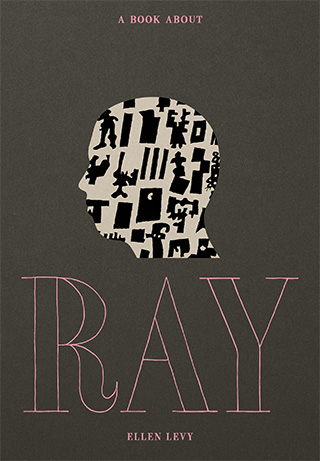Ray Johnson and Emily Dickinson’s Quiet Correspondence

What is an audience? At its root, the word means “a hearing,” as in a courtroom. One’s case was heard by a monarch or other singular authority, and later, by a jury of one’s peers. But if one is an artist, one looks to one’s audience not only for their judgment but for that most elusive of rewards, recognition. You look out, they look back, and you see that you are seen. “The mother’s face, the purpose of the poem,” writes Wallace Stevens, meaning that every glance of recognition takes one back to that initial downturned look.
In the script penciled in between the bars of the red letters that spell FAILURE in a tondo-shaped late collage, the artist does what he can to appease a judgmental crowd:
A OPERA
The curtain opens:
A large BONE. Audience: Ha, ha, ha,
6.14.92
What kind of bone does he throw them? Part of a sentence pops out from the block of prose pasted at the top of the tondo: “the story is that a collage by Ray Johnson can represent any moment at all in a continuing process of information elaboration.” Living as we do in an Age of Information, perhaps this artist has something to teach us about how to thread our way through the deliberately confusing maze of words and images that endlessly unfolds before us wherever we step?

Then again, to get to this thought, we must lean in close to read the small print. Easier just to sit back and repeat the magic words inked across the surface in big block letters: “ONE MILLION DOLLARS ONE MILLION DOLLARS.” They, too, contain a lesson. The story — as told by Frances Beatty, who became director of Ray Johnson’s estate, but who never could get Ray to show with her during his lifetime — is that Johnson had been invited by an old fan, Robert Pincus-Witten, to meet with Pincus-Witten’s employer at the time, gallerist Larry Gagosian, a power player in the New York art world since his arrival in the mid-1980s. Johnson prepared his usual carefully calibrated showing, but once he got to the gallery and set his box of collages before Pincus-Witten, the famously money-minded Gagosian just walked in and snapped, “Ask him how much he wants,” and walked out. Soon afterward, Pincus-Witten received a flyer in the mail that read “RAY JOHNSON COLLAGES ONE MILLION DOLLARS EACH.” Which was not to say that this was their price, but that they were priceless.

The question for Ray Johnson was never, “How much do you want?” but always, “What, what on earth, do you want?” In 1992, Phyllis Stigliano approached Beatty on Johnson’s behalf to talk about his doing a show at Richard Feigen’s gallery, a discussion which, Beatty tells me,
went on for like three and half hours and I would say one thing and she, it was like she was channeling Ray. I said, “would Ray let us see any of the things that he’s doing now?” And I remember she said, “that’s a problem.” And I said, “no it’s not; it’s not a problem. Whatever he’s doing, we’ll show.” Then I said to her, “does he have any idea of the prices of these things?” I thought, might as well ask, and she said, “no.” Finally I said, “you tell Ray that we will do a show of work that we haven’t seen for prices that we don’t know. Tell him that that is fine. That’s fine.”
It was not fine. There was no show. Then, in January 1995, Ray called Frances to say that he had finished doing Nothing and was going to do Something, and after that she could have her show. Ray Johnson: A Memorial Show opened at Richard L. Feigen & Co. in April of that same year.
But the price that Frances had to pay — the price that everyone had to pay — to see all those Ray Johnsons together on the wall was far too high.
Ray Johnson, like Emily Dickinson, dreamed of an unworldly art: the sheen without the moon.
In the FAILURE tondo, Ray Johnson looks back at us from a square tile afloat on black space. Only, if you look very, very closely, you can see that the ground is not entirely flat black, that “James Dean” has been scratched in at left, in shaky cursive, and then covered over again. Dean’s name also appears above in smaller letters, on a white square half-covered by a nascent X. Is the dead star the artist’s intended audience? One tends to think of “audience” as a plural noun, but an audience can also be singular. The recipient of a letter usually opens it alone, and she does so in the absence of the sender, whose envelope was sealed in another space, at another time.
During the last four years of his life, Ray Johnson pursued a new project that came to light only recently, when a curator at the Morgan Library and Museum, Joel Smith, made it the subject of a 2022 show. Johnson never exhibited this body of work and only showed a handful of images from it to a few close friends. The images were photographs made with cheap disposable cameras, depicting a changing set of installations featuring a cast of yard-long, 8-inch wide collages on paperboard that Johnson called “MOVE STARS” — in part because they could be easily moved from location to location in the trunk of his car. These photos recalled the artist’s 1950s street performances with the small, shaped collages he called “moticos,” but, unlike the moticos performances, the Move Star events went largely unwitnessed.
Not long before the advent of the Move Stars, Johnson wrote to a friend of a dream, a “surprising theatre performance type dream, the realization being the isolation the vision of the artist and the performance in an area not the audience area of the artist whose costume and actions are nothing to do with those observing.” The artist is still in the theater, still performing, the audience is still there, somewhere — but at a strange remove.
Four “Move Stars” lean against a tombstone in one of the local graveyards that were among the photographer’s favorite settings for his shoots. Paired at the center are a New York Correspondence School bunny head and a silhouette of Emily Dickinson. Ray Johnson knew enough about the poet to know that she resisted being painted or photographed, that the silhouette is only one of three known lifetime images made of her. He also knew that Dickinson used correspondence to circulate her poems, as an alternative to publication, which she also vigorously resisted. A Johnson collage featuring the Dickinson silhouette includes a cartoon in which the spike-haired cartoon character Nancy tells her Aunt Fritzi, “I was elected secretary of our correspondence club,” to which the aunt replies, “Won’t you have to answer an awful lot of letters?”
He also knew that Dickinson used correspondence to circulate her poems, as an alternative to publication, which she also vigorously resisted.
People ask as well of Emily Dickinson, what, what on earth, did she want? Did she want her poems to be published in her lifetime, despite her theatrical resistance, or at least, did she want them to be published after her death? A poem of hers that Ray Johnson quotes in a letter that he sent in 1950 to a friend from Black Mountain suggests that what Dickinson may have wanted most was not to be had, on earth, at least.
Which is the best—
the Moon or the Crescent?
Neither—said the Moon—
That is best which is not—Achieve it—
You efface the Sheen.
Ray Johnson, like Emily Dickinson, dreamed of an unworldly — a virtually world-less — art: the sheen without the moon. And like her, Johnson dreamed of an audience that might grant him the recognition he craved — that we all crave. It was an audience that, for him as for her, took the form of a particular receiver, separated from the sender in space and time. The sender’s and receiver’s positions are reversible, they are equals, but the distance between them preserves their particularity. A perfect democracy, held in delicate, precarious balance. Unlike the other dream, not impossible on earth, for a moment, at least.
Ellen Levy is the author of “Criminal Ingenuity: Moore, Cornell, Ashbery, and the Struggle Between the Arts” (Oxford University Press) and “A Book About Ray,” from which this article is adapted. Currently a Visiting Associate Professor at Pratt Institute, she has also taught at Vanderbilt University and the School of Visual Arts in New York.



